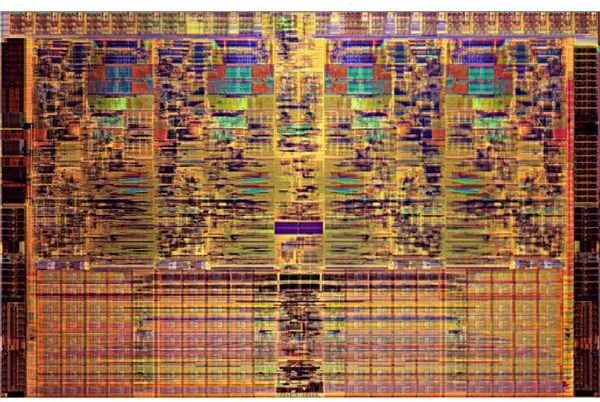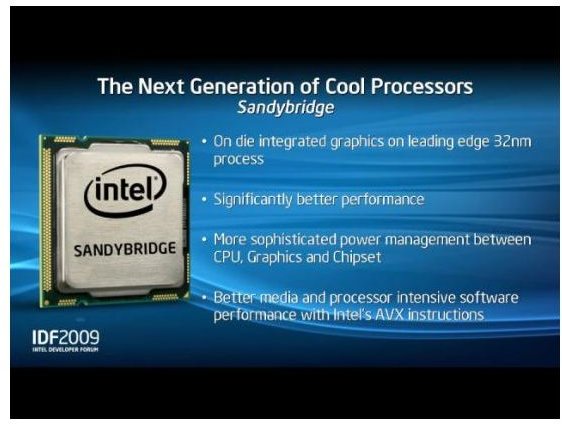A Preview of Intel's Sandy Bridge: The Next Generation of Computer Processing
A Sneak Peak
I still feel as if Nehalem just came out. The processors are blazing fast, and yet there is still some argument in favor of the older Core 2 architecture in mobile products. It doesn’t feel as if we’re well into a new generation of processor architecture, but it has been nearly two years since the first Core i7 processors hit the market.
But today we talk about the future. Sandy Bridge, Intel’s upcoming processor architecture, is due in 2011. It is not a complete overhaul, but it is a major update. So, let’s review what is known about Sandy Bridge so far.
What’s in a Name?
Are you tired of Intel’s naming merry-go-around? Well, too bad. Intel is changing the name structure again for Sandy Bridge. They’re keeping the Core i3/i5/i7 brand labels, but they’re changing how SKUs are represented. A Sandy Bridge Intel Core i5 500 will be called an Intel Core i5 2500. The addition of the 2 in front of the 500 stands for “second generation.”
Intel is also adding a letter suffix to the end of the processor name as appropriate. So far the only suffix known is K. It seems likely we’ll see other suffixes, such as U for Ultra Low Voltage. We’ll talk about what the K means later.
A New Architecture
Intel’s Clarksdale architecture integrated graphics into the same package as the processor, but the graphics processor is still physically separate. This is going to change with Sandy Bridge, which is placing the integrated graphics on the same die. Intel is apparently going to label their chips as having “single core” or “dual core” graphics. Each “core” actually consists of six separate graphics processors called EUs.
The processor itself is still shrouded in some mystery, but is unlikely to be radically redesigned. Improvements will likely focus on evolutionary increases of performance and power efficiency. There will be some changes in how cache is utilized because the on-die graphics will be sharing cache with the processor.
New Sockets and Chipsets
Yes, that’s right. Get out your pitchforks and torches because Intel is, indeed, going to release new sockets and chipsets. The new mainstream chipset will be called LGA-1155. I’m not sure if it is actually going to be a socket that is only one pin off LGA-1156, but that’s what the name implies. Intel is apparently going to replace LGA-1366 with a new socket called LGA-2011, but this will be more towards the end of 2011. Nehalem was led by Intel’s most powerful products, but Sandy Bridge will be led by low-end and mid-range processors.
Pretty damn annoying, isn’t it? This is particularly annoying because at the moment it appears that the first Bulldozer processors from AMD will be compatible with socket AM3. But what can we do? If you don’t like it, buy AMD. Intel has the largest share of the market by far, so they can do whatever they want when it comes to releasing new chipsets.
Overclocking Problems

As if the need to purchase a new chipset wasn’t bad enough, Intel appears to be taking another step that will surely make computer enthusiasts riot. They appear to be putting limits on overclocking. They are doing this by locking down the clock generator, which is now integrated into Sandy Bridge.
So, is that it? Maybe, maybe not. Intel is going to continue making a series of products called the K series. Remember that suffix I was talking about earlier? The K series is Intel’s equivalent to AMD’s Black Edition. You can buy one of these processors if you want to overclock - but you’ll have to pay extra. There also may be some room to overclock by adjusting Turbo Boost settings.
The full picture is not clear yet, so it is hard to say just how difficult overclocking will be. However, it appears Intel is using its market dominance to stop the enthusiast practice of buying a very inexpensive processor and overclocking the snot out of it. Intel doesn’t want you to do that - they want you to buy the more expensive processor.
Performance
It is obviously not possible to determine the performance of a processor before it is in full production. However, Anandtech got its hands on a sample and did some tests. The sample they received is a pre-production version of the Core i5 2400. It is not known if the integrated graphics on the processor include 6 or 12 EUs.
The graphics performance is roughly equivalent to a Radeon 5450 in a variety of games. That’s impressive, and will deal a serious blow to the low-end discrete graphics market. If this proves to be a part with only 6 EUs it is particularly bad news for discrete graphics, because it would suggest that a 12 EU part might actually be sufficient for gamers playing on low-resolution monitors.
The processor performance also proved to be good. The Core i5 2400 sample was able to defeat the Core i7 880 in a variety of tests and was between 20% and 30% faster than the Core i5 760, the processor the Core i5 2400 is likely to replace.
Overall
Sandy Bridge is still months from release, but the pre-production information suggests it will be a solid competitor. Nehalem is already extremely quick, and Sandy Bridge appears as if it will be a not insignificant improvement.
Of course, AMD also has a brand new architecture with a radically different design, called Bulldozer, slated for release in 2011. Which will be better? That’s impossible to judge right now, but it does appear that AMD will have to bring its A-game if Bulldozer is to stand any chance.
